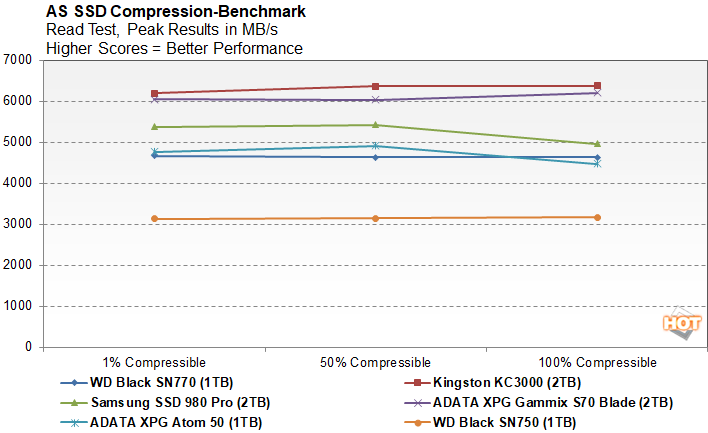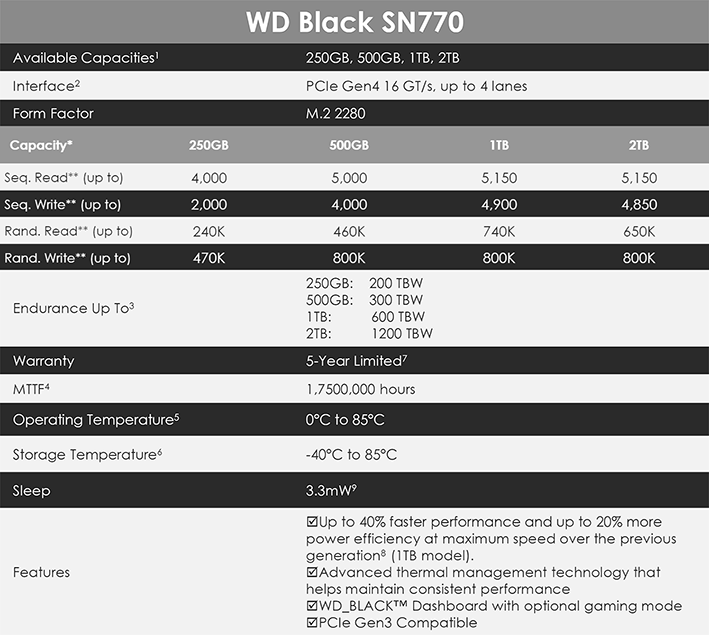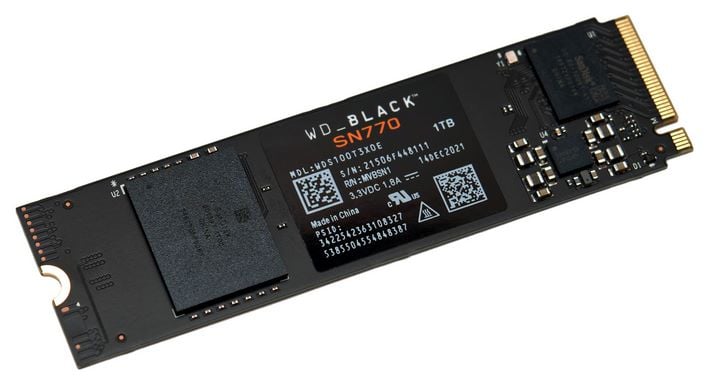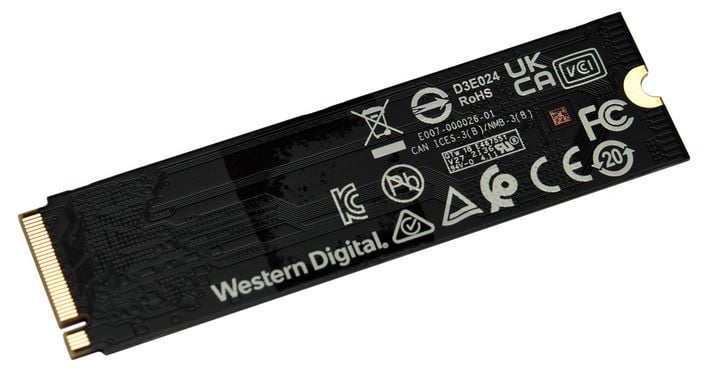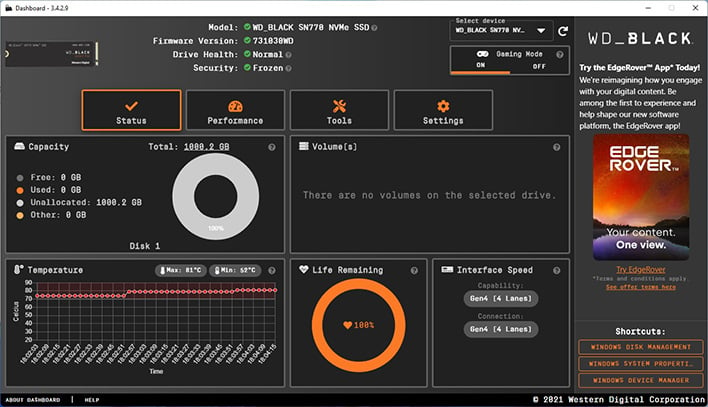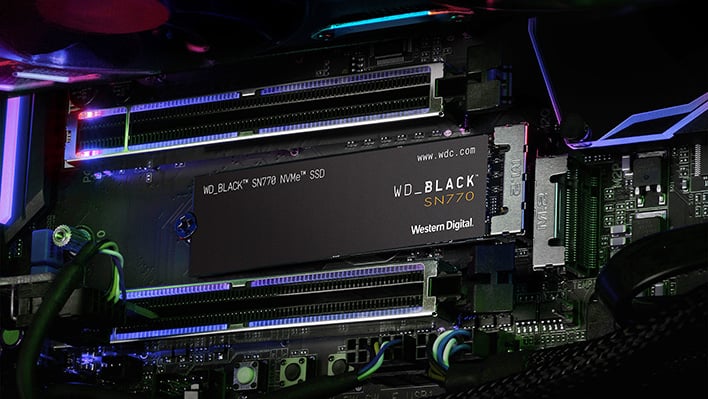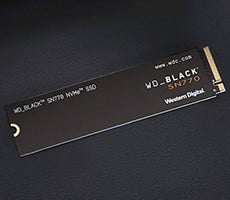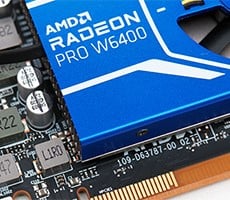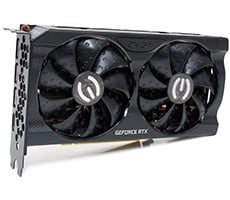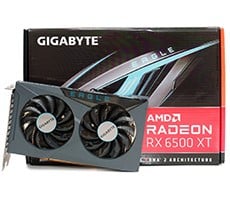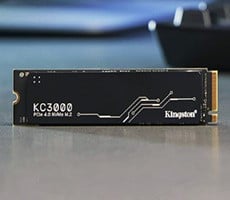WD Black SN770 SSD Review: Killer Gen 4 Storage For Gamers
We’ll get to the particulars shortly. For now, here’s the spec and feature breakdown for the new WD Black SN770 series. Pics to follow, and then – of course – plenty of benchmarks...
WD Black SN770 Specifications And Features
As you peruse the specs above, you’ll notice that the 1TB WD Black SN770 is the highest performing model in the line-up. The different NAND, controller and firmware configurations on the drives result in significantly different performance overall, especially in terms of writes. The drive we’ll be testing here is a 1TB model.
The WD Black SN770 uses a new Western Digital 4-channel controller that was developed in-house. That controller is paired to new BiCS5 TLC NAND flash memory, but there is no DRAM on the drive to speak of. A configuration like this is usually associated with entry-level, lower-performing drives, but as you’ll see a little later, the SN770 performs well where it matters most.
The WD Black SN770 has the same form factor as most other consumer NVMe SSDs – it’s an M.2 2280 gumstick. The back side of the PCB is flat and devoid of any components, while the top side features the controller, NAND, and various other surface mount components.
You’ll notice that WD spreads the NAND and controller far apart on the PCB to best manage thermals. The controller is tight up against the M.2 connector and the NAND is far away, at the other end of the PCB, with enough space to around heat to dissipate all around. In conjunction with a 20% improvement in power efficiency, WD claims this arrangement will minimize thermal throttling. And even if the drive does throttle due to heat, it recovers quicker and offers higher performance over older drives anyway.
If WD’s Dashboard software is reading the sensors in the drive correctly, however, the SN770 does get pretty toasty under a sustained load, at least when Game mode is enabled. We saw a peak temperature of 81°C after two complete writes across the entire capacity of the drive in that configuration. With Game mode disabled though, which is how the drive is configured by default, temperatures are a bit lower. Performing the same test with Game mode disabled resulted in a maximum temperature of 75°C. With temps like this, if you’re going to stick the SN770 in a motherboard that doesn’t have M.2 heatsinks, make sure there’s good air-flow over the drive. Enabling Gaming Mode on the SN770 essentially disables any power-saving / sleep features, so the drive is always at the ready. Toggling the feature on and off had only minimal impact on the benchmarks we ran (as you’ll see a little later), but may theoretically minimize stutter or occasional hiccups in games that don't access the storage subsystem very often.
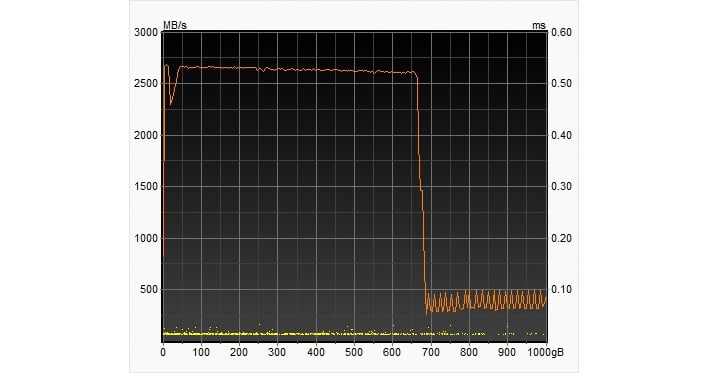
Like many other NVMe solid state drives on the market that feature TLC NAND, the WD Black SN770 will use a portion of NAND as an SLC cache to boost write speeds. Data is first written to the SLC blocks to maximize performance, but should the SLC cache be saturated, data can still be written direct to the TLC NAND. But when the cache is exhausted, write performance will drop off. On the 1TB drive, 650GB had to be written before that happened.
According to its published specifications, the 1TB WD Black SN770 offers up to 5.15GB/s reads, with 4.9GB/s writes. Random 4K IOPS are rated for up to 740K (reads) and 800K (writes), and endurance is rated at 600 TBW over its 5-year warranty period for the 1TB drive. The smaller capacity drives in the family offer lower overall endurance, however, which is typical. Endurance is basically 200TBW per 250GB of capacity with the SN770.
There isn’t much included in the WD Black SN770’s retail packaging over and above the drive and some basic literature, but Acronis True Image WD Edition and the WD SSD Dashboard software are available for download via the company’s website, should you want to use them for cloning and/or maintenance purposes.
WD Black SN770 PCIe Gen 4 SSD Benchmarks
Under each test condition, the SSDs showcased here were installed as secondary volumes in our testbed, with a separate drive used for the OS and benchmark installations. Our testbed's motherboard was updated with the latest BIOS available at the time of publication and Windows 11 was fully updated. Windows firewall, automatic updates, and screen savers were all disabled before testing and Focus Assist was enabled to prevent any interruptions.
In all test runs, we rebooted the system, ensured all temp and prefetch data was purged, and waited several minutes for drive activity to settle and for the system to reach an idle state before invoking a test. All of the drives here have also been updated to their latest firmware as of press time. Where applicable, we would also typically use any proprietary NVMe drivers available from a given manufacturer, but all of the drives featured here used the Microsoft driver included with Windows 11.
HotHardware's Test System:
| Processor: AMD Ryzen 9 5950X Motherboard: Gigabyte Aorus X570 Pro Wi-Fi (X570 Chipset) Video Card: GeForce RTX 3080 Memory: 32GB G.SKILL DDR4-3200 Storage: Samsung SSD 980 Pro (OS Drive) ADATA XPG GAMMIX S70 Blade (2TB) ADATA XPG Atom 50 (1TB) Samsung SSD 980 Pro (2TB) Kingston KC3000 (2TB) WD Black SN750 (1TB) WD Black SN770 (1TB) |
OS: Windows 11 Pro x64 Chipset Drivers: AMD v3.10.22.706 Benchmarks: IOMeter 1.1 HD Tune v5.75 ATTO v4.01.02f AS SSD SiSoftware SANDRA CrystalDiskMark v8.0.4 x64 Final Fantasy XiV: Endwalker PCMark 10 Quick Storage Bench |
IOMeter Benchmarks
IOMeter is a well-respected industry standard benchmark. However, despite our results with IOMeter scaling as expected, it is debatable as to whether or not certain access patterns actually provide a valid example of real-world performance. The access patterns we tested may not reflect your particular workloads, for example. That said, we do think IOMeter is a reliable gauge for relative throughput, latency, and bandwidth with a given storage solution. In addition, there are certain highly-strenuous workloads you can place on a drive with IOMeter, that you can't with most other storage benchmark tools.In the following tables, we're showing two sets of access patterns; a custom Workstation pattern, with an 8K transfer size, consisting of 80% reads (20% writes) and 80% random (20% sequential) access and a 4K access pattern with a 4K transfer size, comprised of 67% reads (33% writes) and 100% random access. Queue depths from 1 to 16 were tested...
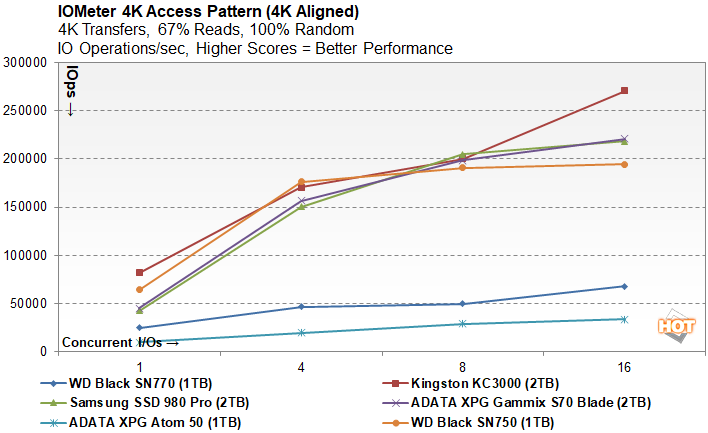
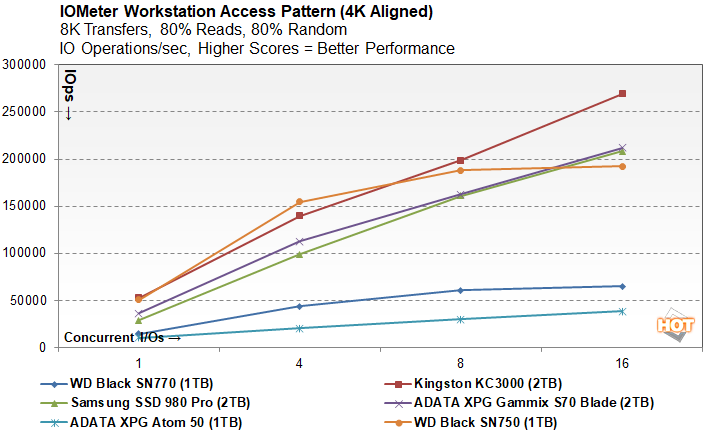
We've got a varied mix of drives here to illustrate the performance differences between the previous-gen WD Black SN750 (PCIe Gen 3), high-end PCIe Gen 4 drives, and mainstream PCIe Gen 4 DRAM-less drives, like the new WD Black SN770 and ADATA XPG Atom 50. As you can see, the drives with DRAM clearly offer higher IO performance, across all queue depths. The WD Black SN770, however, is a notch ahead of the Atom 50.
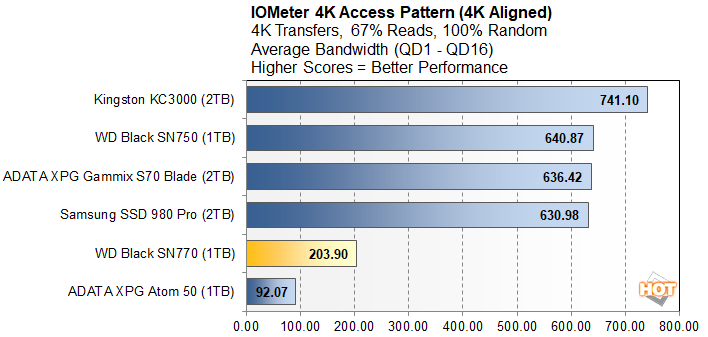

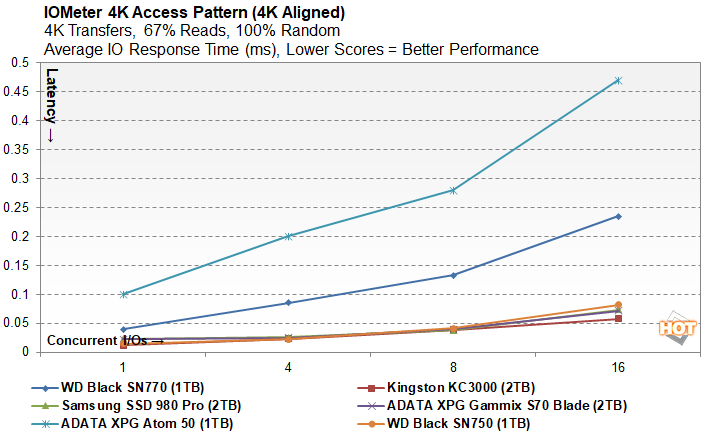
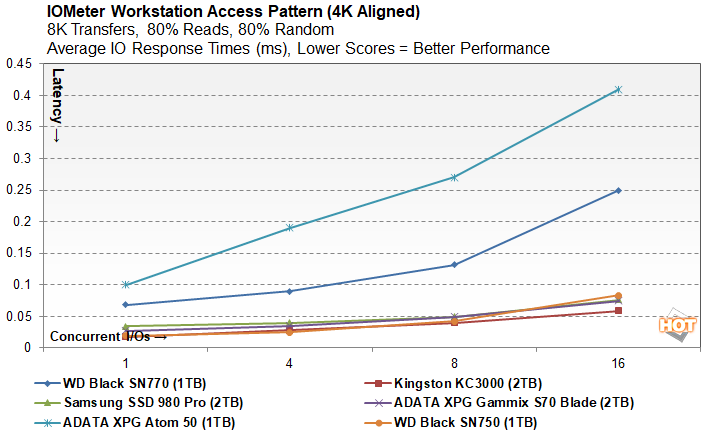
Our latency results also show the higher-end drives offering lower latencies across all queue depths. The WD Black SN770, however, offered a significant reduction in latency versus the other DRAM-less drive in the mix.
SiSoft SANDRA 2021
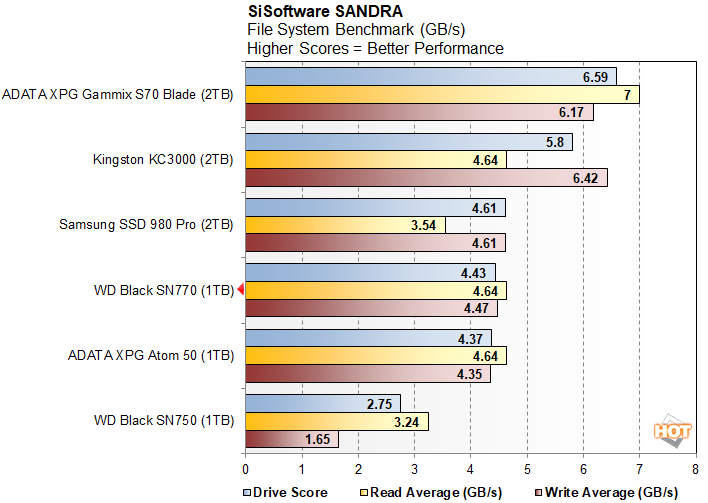
The SANDRA file system benchmark had the new WD Black SN770 landing right in the middle of the bunch. The WD Black SN770 offered significantly more bandwidth than the previous-gen SN750 and just edged out the ADATA XPG Atom 50. The WD Black SN770 also offered more read bandwidth than the Samsung drive and tied with the Phison-based KC3000 in regard to reads as well.
ATTO Disk Benchmark
ATTO is another "quick and dirty" type of disk benchmark that measures transfer speeds across a specific volume length. It measures raw transfer rates for both reads and writes and graphs them out in an easily interpreted chart. We chose .5KB through 64MB transfer sizes and a queue depth of 6 over a total max volume length of 256MB. ATTO's workloads are sequential in nature and measure raw bandwidth, rather than I/O response time, access latency, etc.
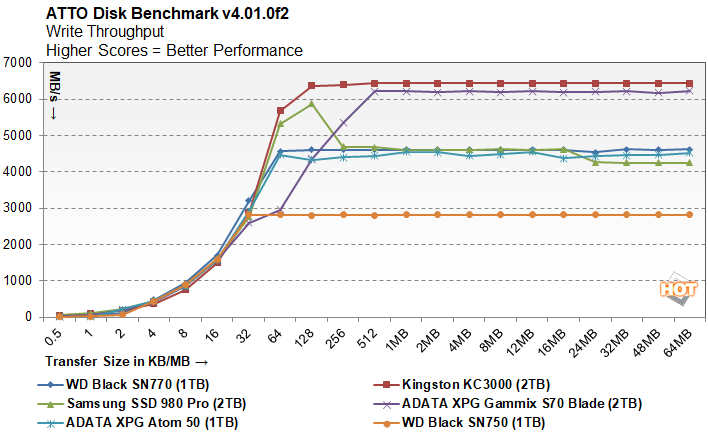
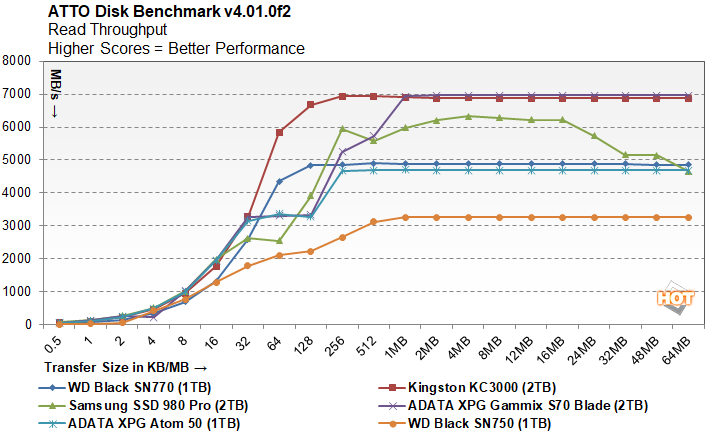
The WD Black SN770 finishes in the middle of the pack in terms of read and write bandwidth in the ATTO Disk Benchmark, which is expected with this mix of drives. We should note, however, that the WD Black SN770 actually managed to put up numbers higher than its rated specs but a few MB/s, so WD may be a bit conservative in those ratings.
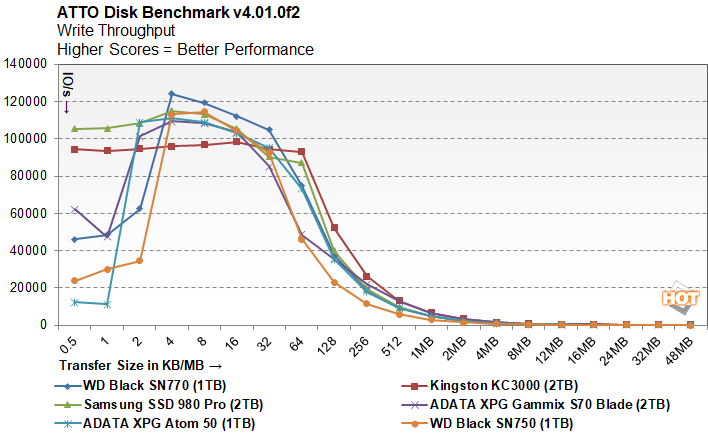
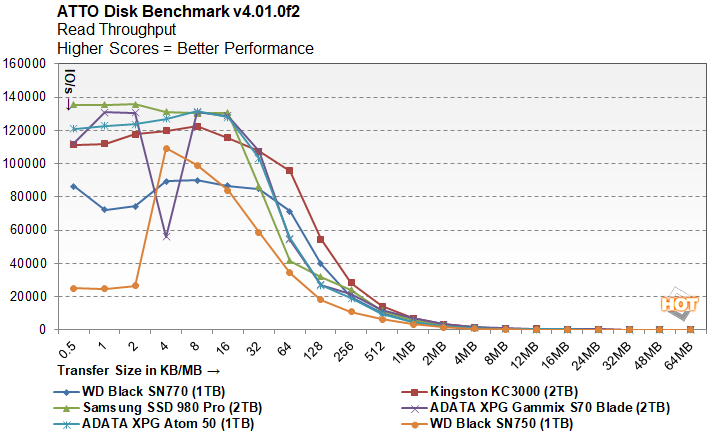
IO performance according to ATTO had the WD Black SN770 finishing about in the middle of the pack once again in the read test. In the write test though, once the transfer size hits 4K, the WD Black SN770 actually finished on top until hitting the 64K mark.
AS SSD Compression Benchmark
Next up we ran the Compression Benchmark built-into AS SSD, an SSD specific benchmark being developed by Alex Intelligent Software. This test is interesting because it uses a mix of compressible and non-compressible data and outputs both Read and Write throughput of the drive. We only graphed a small fraction of the data (1% compressible, 50% compressible, and 100% compressible), but the trend is representative of the benchmark’s complete results.
